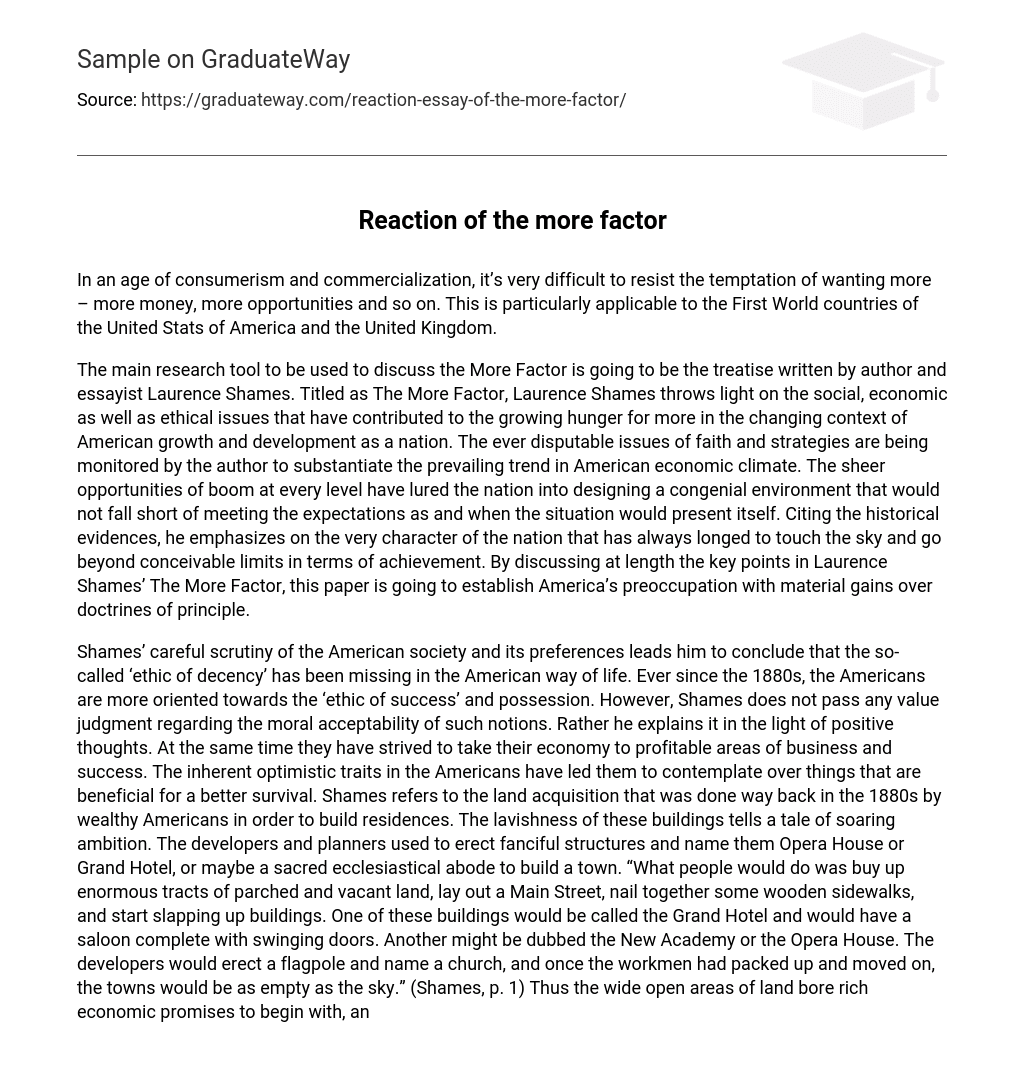In an age of consumerism and commercialization, it’s very difficult to resist the temptation of wanting more – more money, more opportunities and so on. This is particularly applicable to the First World countries of the United Stats of America and the United Kingdom.
The main research tool to be used to discuss the More Factor is going to be the treatise written by author and essayist Laurence Shames. Titled as The More Factor, Laurence Shames throws light on the social, economic as well as ethical issues that have contributed to the growing hunger for more in the changing context of American growth and development as a nation. The ever disputable issues of faith and strategies are being monitored by the author to substantiate the prevailing trend in American economic climate. The sheer opportunities of boom at every level have lured the nation into designing a congenial environment that would not fall short of meeting the expectations as and when the situation would present itself. Citing the historical evidences, he emphasizes on the very character of the nation that has always longed to touch the sky and go beyond conceivable limits in terms of achievement. By discussing at length the key points in Laurence Shames’ The More Factor, this paper is going to establish America’s preoccupation with material gains over doctrines of principle.
Shames’ careful scrutiny of the American society and its preferences leads him to conclude that the so-called ‘ethic of decency’ has been missing in the American way of life. Ever since the 1880s, the Americans are more oriented towards the ‘ethic of success’ and possession. However, Shames does not pass any value judgment regarding the moral acceptability of such notions. Rather he explains it in the light of positive thoughts. At the same time they have strived to take their economy to profitable areas of business and success. The inherent optimistic traits in the Americans have led them to contemplate over things that are beneficial for a better survival. Shames refers to the land acquisition that was done way back in the 1880s by wealthy Americans in order to build residences. The lavishness of these buildings tells a tale of soaring ambition. The developers and planners used to erect fanciful structures and name them Opera House or Grand Hotel, or maybe a sacred ecclesiastical abode to build a town. “What people would do was buy up enormous tracts of parched and vacant land, lay out a Main Street, nail together some wooden sidewalks, and start slapping up buildings. One of these buildings would be called the Grand Hotel and would have a saloon complete with swinging doors. Another might be dubbed the New Academy or the Opera House. The developers would erect a flagpole and name a church, and once the workmen had packed up and moved on, the towns would be as empty as the sky.” (Shames, p. 1) Thus the wide open areas of land bore rich economic promises to begin with, and the democratic social system was established without the intervention of constitution. Moreover, the vastness of land seemed to generate a tremendous ambition in the minds of the native people to utilize the resources to their prosperity and well being.
The concept of more is directly proportionate with expansion. Shames argues that to get more, the system must lay emphasis more on generating quantities of money than on improving the standards of living. The progress of a nation, if examined closely, is not just for the sake of it, but is the reasons behind it. Based on such conjectures, the crisis of modern day America has been put in the most precise manner possible: “If the supply of more went on forever, perhaps that wouldn’t matter very much. Expansion could remain a goal unto itself, and would continue to generate a value system based on bulk rather than on quality of life, on “progress” itself rather than on a sense of what progress was for. But what if, over time, there was less more to be had?” (Shames, p. 79)
Now to address such a paradoxical question, one might consider the realistic situation of the nation first. The United States of America is never running short of wealth nor does it exhaust the resources that generate the wealth. There are opportunities galore in the country when it comes to earning a decent living. But the US preoccupation with wanting more is posing an imminent threat to the fulfillment of the same. In this regard, Shames picks up a relevant topic of discussion that has been troubling the economists for a long time now. Productivity growth, according to financial experts, can never be a trusted parameter to calculate changes in real wealth. A span of 22 years from 1947 to 1965 witnessed 3.3% per capita productivity on an average basis. It meant that each hour of labor put in by an American worker contributed 3.3 cents to the US dollar. This percentage kept on decreasing steadily as years went by, and by the 1980s, it came to a deadlock with just 0.2% per capita productivity. However, this kind of slump was not recorded in real wealth of the US citizens. (Shames, p. 79)
In relation with the thesis statement, it can be said that the American society at present is more inclined toward maximizing its economic benefits. However slump there may be in the U. S. per capita productivity, the fact still remains that the overwhelming desire to possess more has acted as a psychological incentive in terms of getting back to the realistic picture of consumerism. As a nation blessed with vast acres of land and huge intellectual potential, the United States of America looks ahead in the new millennium with renewed hopes of earning more to live more – at least quantitatively, even if not qualitatively.
Work Cited
Shames, Laurence. “The More Factor.” Signs of Life. 5th ed. Eds. Sonia Maasik and Jack
Solomon. New York: Bedford/St. Martin’s, 2006. 76-81





